
Simple machines (O-level physics)

Machines
A machine is a device that makes work easier.
In machines, an effort (force in Newtons) is applied to move the load.
The effort can be
A muscular effort from man or
Force derived from an engine.
Principle of simple machines
The principle used in a simple machine is to produce a bi force overall small distance by using a small force over a large distance.
The force which we apply to the machine is known as effort (E) and the load we have to overcome is known as the load (L). both force and load are measured in newtons.
Types of machines
- Simple machines
- Complex machine
Simple machines
These are devices that work with one movement and change the size and direction of the force.
Examples of simple machines include levers, pulley, hydraulic, gears, screws, and inclined planes
Levers
A lever is a rigid bar which is free to move about a fixed point, the Fulcrum or pivot
Levers are divided into three classes
(i) The first-class levers
(ii) The second class lever and,
(iii) Third class levers
(a) First-class lever
This is a type of lever in which the fulcrum is between the effort and the load.
Examples of the first-class lever include Craw bar, scissor, beam balance, scissor and pair of pliers,
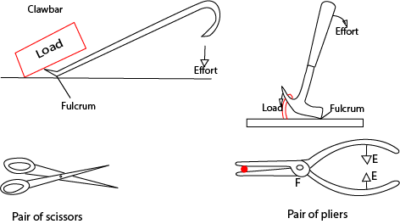

(b) Second class lever
Here the load is between the effort and fulcrum.
Examples are a wheelbarrow, nutcracker, and office punch


(c) Third class lever
Here the effort is between the load and fulcrum.
Examples are a wheelbarrow, nutcracker and office punch


Mechanical advantage (M.A)
This is the ratio between the load and the effort applied.


Significance of mechanical advantage
The bigger the mechanical advantage the better the machine since small effort can lift a bigger load.
Factors that may lower mechanical advantage
Friction; the higher the friction the lower the mechanical advantage
Weight of moving parts: the heavier the parts the lower the mechanical advantage
Velocity ratio
This is the ratio of the distance moved by effort over the distance moved by the load


Velocity ratio has no units
Significance of velocity ratio
The bigger the velocity ratio the less effort required to do work and the more efficient the machine.
In other words, the machines require less effort to overcome a big load when effort moves a bigger distance compared to the load in a unit time.
Example
A load of 100N is raised through 6m when an effort of 40N moves through 24m.
Calculate
(i) mechanical advantage
(ii) velocity ratio
Solution


Pulleys
A pulley is a wheel with a groove ring that passes or string.
- The effort is applied to one end of the rope and the disk of the pulley rotate as the rope moves over it
- If there are several pulleys in a framework, it is called a block
Types of pulley
Pulleys may be categorized into
- Single fixed pulley
- Single movable pulley
- Block and Tackle system
Pulleys reduce the effort to lift an object by increasing the distance and /or direction over which the effort is applied.
(a) Single fixed Pulley
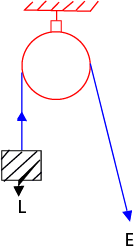

A single fixed pulley is a single wheel with concave grooves fixed to support as shown in the figure above. A rope, chain, or cable passes over the groove of the pulley. One end of the rope is attached to the load and the effort is applied at the other end.
If a user pulls down on one end of the rope (Effort), the other end (Load) will raise up an equal distance in the opposite direction
The primary benefit of a single fixed pulley is to change the direction of the effort to move a load to a point (such as the top of a flagpole)that cannot be reached by the user.
Characteristics of a fixed pulley system
(i) It has one wheel inside the pulley
(ii) The pulley is mounted to a strong solid support
(iii) Its mechanical advantage = 1
(iv) Velocity ratio = 1
(v) It is a first-class lever because the fulcrum is between the effort and the load
(vi) Has uniform tension in the rope
Application of a single pulley system
(i) Removing water from a well
(ii) Lifting building material in the site
(b) A single movable Pulley


This is a pulley that moves along with the load attached to it. One end of the rope is tied to a fixed support and passes over the pulley and the other end where effort is applied makes a U-turn to the user as shown below.
Characteristics of the single fixed pulley
(i) Its mechanical advantage = 2, that is the effort required to lift the load is half the size of the load.
(ii) Its velocity ration = 2, that is the effort moves twice the distance moved by the load.
Block and Tackle system
This is a pulley system consisting of both fixed and movable pulleys as shown below

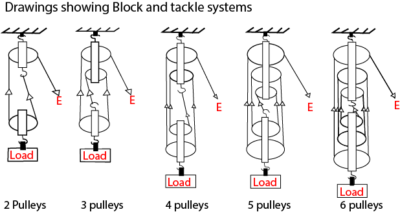
The framework of pulleys is called block and the rope passing over each pulley is called tackle.
Characteristics of the block and tackle system
- Mechanical advantage (MA) = n (number of pulleys in the system
- Velocity ration (VR) = n (number of strings supporting the load or number of pulleys in the system)
Application of Block and Tackle
They are commonly used to raise or move load in
- Sailing
- Crane
- Lifts
- breakdown
Example 2
A force of 10N is required to raize a load, L, using a smooth (frictionless) and weightless block and tackle system of four pulleys. Calculate:
(i) Load
(ii) M.A
(iii) Effrt distance if the load rises by 2m
Solution
Given
E = 10N, M.A = ?, Effort dis. ? Load distance = 2m L ? No of pulleys = 4
(a)(i) in equilibrium
Downward force = upward force
L = 4E = 4 x 10 = 40N
(ii) mechanical advantage


(iii) Neglecting friction,
Work in put = work out put
Work done by effort = work done by load
Effort x effort distance = Load x distance
E x E.d = L x L.d
10 x E.d = 40 x 2
Effort distance = 8
Therefore, effort distance = 8m
Efficiency of machines
The efficiency of a machine indicates how well its input energy is converted to useful output energy or work.
n= MA / VR
Efficiency = Mechanical Advantage / Velocity ratio.
In an ideal machine (with no friction), the efficiency = 1, also known as 100%.
How can efficiency be increased
- Machines can be made more efficient by reducing friction. This usually is done by adding a lubricant, such as oil or grease, to surfaces that rub together
- For the case of pulleys, by making the string and the block plus the pulleys as light as possible.
Graphical relationship between M.A and Load
When M.A or n are plotted against load, the following graphs are obtained.


Explanation of the shape of the graph
In both, a small increase in load cause a high increase in M.A and efficiency, n. on the further increase on the load, graphs begin to level as M.A and efficiency reach their maximum values and the remain constant.
The efficiency of the pulley system increase with the load because when the load is small, the weight of the lower moving pulley block and friction is significant.
The weight of the lower movable pulley block and friction become negligible to the load as the size of the lad increases.
NB. For figure (a), the graph levels at the value of M.A. while (b), the graph levels below 100% for imperfect machine and levels at 100% for perfect machines
Example 3
(a) Define the following terms
(i) Mechanical advantage
(ii) Velocity ration
(b) The diagram in the figure shows a pulley system used to raise the load

(i) What is the velocity ratio of the system
(ii) Find how far the load is raised if the effort moves down by 4m
(iii) Calculate the effort required to raise a load of 800N, if MA = 4
(c) Explain what happens to the efficiency of the system in (b) above if the load is much
(i) Less than 800N
(ii) More than 800N
(d) Draw a sketch graph to show how mechanical advantage of the system in (b) varies with the load
(e) Give two practical applications where the pulleys are used.
Solution
(a) (i) mechanical advantage is the ratio of load to the effort
(ii) Velocity ratio is the ratio of effort distance to load distance
(b) (i) VR = number of pulleys = 5
Effort distance = 4m, load distance = ?, V.R = 5


Load distance = 0.8m
(iii) E = ?, L = 800N, M.A = 4


(d)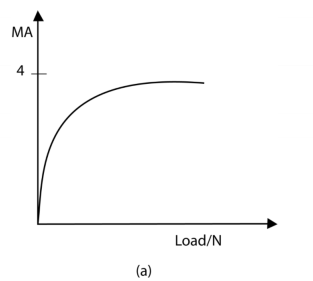

(e) they are used in cranes, breakdown, ships, for lifting
Inclined Plane
This refers to a type of a machine in which a plane is inclined to an angle to the horizontal such that one end is higher than the other. by angle Θ


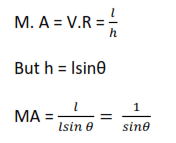
- it used to lift heavy load by pulling/pushing it along the sloping surface.
- It is easier to carry the load along the slope than lifting it through the vertical height, h, since the weight of the load acts vertically downwards (and only a component of weight acts along the plane)
- In order to raise the load through a vertical height, h, the effort, E is applied through a longer distance, l, equal to the length of the plane.
Examples of inclined plane include
(i) Slopping roads
(ii) Staircase
Properties of inclined planes


Example 3
A load of 40N ispulled steadily from A to B along inclined plane by a force F as shown in the figure. Find the velocity ratio of the system.
- 1.0 B. 1.2 C. 2.0 D. 4


AC = 10 cm, Bc = ? θ = 300
BC = AC x sin30 = 10 x 0.5 = 5cm


Answer is C
Example 4
A wooden plank 3m long is used to raise a load of 1200N through a vertical height of 60 cm. if the frictional force between the load and the plane is 40N. calculate
(a) The effort required
(b) The mechanical advantage
Solution


Given: L = 1200N, E = ? l = 3m, h = 60cm = 0.6m, friction force = 40N
- Work input = work out put + useless work done
Work done by effort = work done by load + work by frictional force
Effort x effort distance = Load x load distance + friction force x Effort distance
E X 3 = 1200 x 0.6 + 40 x 3
E = 280N


Example 5
A man uses the incline plane to lift a 50 kg load through a vertical height of 4.0m. the inclined the incline plane makes an angle of 300 with the horizontal. If the efficiency of the plane is 72%, calculate
(a) The effort needed to move the load up the inclined plane at a constant velocity
(b) The work done against friction in raising the load through the height of 4.0m (take g = 10Nkg-1)
Solution



The Wedges
The wedge is a kind of simple machine which is an inclined plane having one or two sloping sides. With a wedge, the sloping surface is pushed through the material which is held still.
Examples of wedges are: Knife, axe, chisel, needle, nail, razor blade
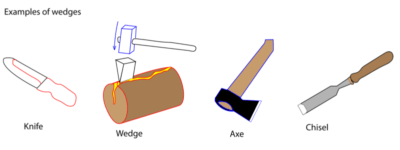

Uses of wedges include: Cutting, pitching
Wheel and axle
A wheel and axle is a type of simple machine made up of a wheel and axles rigidly attached to each other so that they turn together about an axis.
The effort is applied to the larger wheel and the load is raised by string attached to the axle of small diameter as show below:
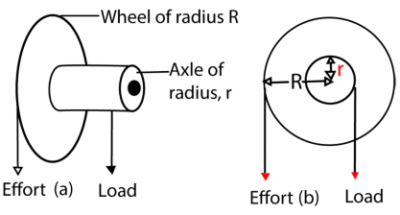

For one complete turn, the load and effort move through distances equal to the circumference of the wheel and axle respectively.
Characteristic of Wheel and axle


Uses of wheel and axle
- The car steering wheel
- Screwdriver
- Windlass (used to raise a heavy bucket of water in a well.
Example 6
The figure below shows a wheel and axle system. When an effort of 300N is applied, a load of 900N is raised through a distance of 1.0m.


Calculate
(a) Velocity ratio
(b) The efficiency of the machine
Solution
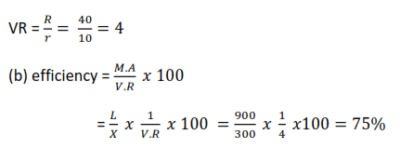

Example 7
A wheel and axle is used to raise a load of 280N by a force of 40N applied to the rim of the wheel. If the radii of the wheel and axle are 70cm and 5cm respectively, calculate the M.A, V.R and the efficiency.

Solution



Gears
A gear is a device that consists of a set of toothed wheels. Gears change the direction and speed of rotation. They are similar to the wheel and axle. In the gear wheel, the effort and the load are applied to the shafts connected to the gears.




The velocity ratio of gears depends on which gear wheel is the effort applied.
Torque may be applied to the smaller gear in order to increase the torque and decrease the rate of rotation of the larger gear.
Or
Torque may be applied to the larger gear in order to decrease torque and increase the rate of rotation in the smaller gear.
Example 7
Two gear wheels A and B with 20 and 10 teeth respectively lock into each other. They are fastened on axles of equal diameter such that a weight of 100N attached to a string wound around one axle raises a load of 160N attached to a string wound around the other axles.
Calculate
(a) (i) the velocity ratio
(ii) The efficiency of the system when a small gear wheel is the driven gear
(b) (i) the velocity ratio
(ii) The efficiency of the system when a big gear wheel is the driven gear
Solution


The screw
A screw may be considered as continuous inclined plane wound around a cylindrical threaded rod.


- The distance between two successive threads is called a pitch
- In one revolution, the screw moves forward (or backward) through a distance of equal to one pitch.
- Effort distance equals the circumference of the screw head (2πR)
- Load distance equals the length of the pitch.
- When a screw is combined with lever can be used as a jack for lifting heavy loads such cars
The velocity ration of screws


Example 8
(a) In a screw jack the length of the handle is 24cm and the screw pitch is 2mm if it is used to raise a car of mass 2000kg, calculate
(i) The effort required
(ii) The V.R
(iii) The M.A
(b) Comment the value of M.A obtained in (a)(iii) above
(Take g= 10ms-2, π = 3.14)
Solution
L = 24 cm = , pitch =2mm = , L = 2000 kg = 2000 x 10 = 20000N, E = ?


(b) MA = VR because the screw jack is assumed to be perfect, i.e. frictionless
NB in practice the effort must be higher than 26.54N in order to overcome friction
Example 9
A car weighing 1600 kg is lifted with a jack-screw of 11mm pitch. If the handle is 28cm from the screw, find the force applied.
Solution
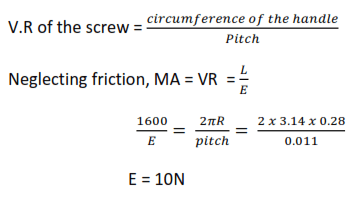
Sponsored by The Science Foundation college +256 753 80 27 09
Compiled by Dr. Bbosa Science
Thank you

A very good notes
Good notes Sir
Good notes sir, thanks alot
Thanks sir but I would ask for more help
I’m in Luzira SS and your notes help me alot
thanks
Thanks for the notes sir
Thanks for providing such valuable insights. Toys & Games
I’m excited to see what’s next! Sports News
Explore the MBBS Fees Structure in Andhra Pradesh for top institutions offering quality education.
Boost your gaming experience with the special Raja Luck Invite Code.
great issues altogether, you just gained a new reader. What could you suggest in regards to your put up that you made some days ago? Any certain?
my web site :: http://boyarka-inform.com/